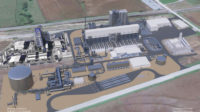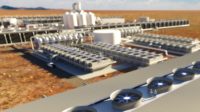The U.S. Dept. of Energy is putting $251 million toward 12 infrastructure projects targeting carbon emissions from power generation and other industrial operations.
The funding, from the Infrastructure Investment and Jobs Act, is intended to improve air quality and reduce impacts of climate change while supporting job-creating economic opportunities by capturing, transporting and converting or storing hundreds of millions of tons of CO2 emissions, DOE officials say.
“Thanks to historic clean energy investments, DOE is building out the infrastructure needed to slash harmful carbon pollution from industry and the power sector, revitalize local economies, and unlock enormous public health benefits,” Energy Secretary Jennifer Granholm said in a statement.
The announcement follows a U.S. Environmental Protection Agency proposed rule earlier this month that would require high-emitting power plants to install carbon capture and sequestration equipment.
DOE says nine of the projects would develop or expand commercial-scale carbon storage projects in conjunction with its CarbonSAFE program, with each project able to store 50 million or more metric tons of CO2.
The largest single award amount was $40.5 million to the University of Wyoming, which is working with the company Frontier Carbon Solutions to advance a large-scale carbon capture and storage facility called Sweetwater Carbon Storage Hub.
The hub would be strategically placed near trona sodium carbonate mining and other industrial CO2 emission sources in southwest Wyoming, according to Scott Quillinan, a geologist and research director at the University of Wyoming School of Energy Research. The area is also home to geologic reservoirs, which he calls “a world-class resource for carbon storage” because of their depth, thickness and lack of oil or gas.
The reservoirs allow captured carbon to be stored deep underground.
 Sweetwater Carbon Storage Hub in southwestern Wyoming.would include three injection wells and a monitoring wel.. Map via Wyoming Dept. of Environmental Quality
Sweetwater Carbon Storage Hub in southwestern Wyoming.would include three injection wells and a monitoring wel.. Map via Wyoming Dept. of Environmental Quality
The team plans to use the awarded funds to install three characterization wells that would then be turned over as injection wells, and for a deep monitoring network, Quillinan says. Outside the scope of this award, the project would also require the capture equipment on industrial sources in the area and a pipeline to transport the captured carbon.
Other awarded carbon dioxide storage and transportation projects are located in Texas, Colorado, Louisiana, Alabama, Illinois and North Dakota. DOE also awarded funds for engineering design studies of three planned regional carbon dioxide pipeline networks in Wyoming and Texas. Officials say it also has allocated more than $747 million since January 2021 toward carbon management projects, including carbon capture, conversion and storage.
Jessie Stolark, executive director of the Carbon Capture Coalition, a group of companies, environmental groups and others focused on commercial scale deployment of carbon capture technologies, praised DOE’s announcement for helping meet emissions reduction goals and ensuring long term viability of key domestic industries.
“The U.S. has abundant, well characterized carbon storage capacity that can safely and permanently store billions of tons of carbon dioxide emissions, but currently lacks the necessary infrastructure and capture facilities to fully utilize this potential,” Stolark said in a statement.






